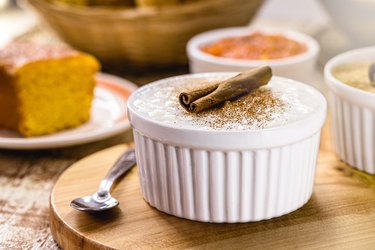
Rice pudding and tapioca pudding are both sweet desserts with a similar texture, but they are not the same thing. What is tapioca made of? While rice pudding is made with rice, tapioca is made from processed cassava, or manioc root (Manihot esculenta). Rice pudding has a long history, and many varieties of the treat are found in cultures around the world. Both types of pudding are easy to digest.
What Is Tapioca Pudding?
Video of the Day
Where does tapioca come from? The cassava plant originated in Brazil. The exact origin of tapioca pudding is not known, but it may have originated in China or in the Mayan culture.
Video of the Day
The tapioca pudding with which most Americans are familiar was invented by a woman named Susan Stavers in 1984. She used the cassava roots that were brought by a sick sailor who was boarding in her home to make the pudding, and she eventually sold the recipe to Minute Tapioca Company. Most tapioca needed to be soaked before using it in pudding, but Minute tapioca does not need to be soaked.
What is tapioca made from? The gelatinous balls in the pudding are the cassava root. Other ingredients typically include milk, cream, eggs and sugar. Tapioca pudding is generally higher in sugar than rice pudding, although recipes can vary.
What Is Rice Pudding?
As the name suggests, rice pudding is made from cooked rice. Other ingredients typically include condensed milk, eggs and vanilla. As with tapioca pudding, the origins of this dessert are unknown, but it may have come from China or India. While today many people think of rice as a food staple, historically, it was used medicinally or as a thickening agent. Medicinally, it was prescribed to individuals of all ages suffering from stomach problems.
There have been many varieties of rice pudding throughout the years. Some may have a creamier texture, while others may have a stickier texture.
Since rice has such a mild flavor, there are countless flavor combinations you can try. Middle Eastern recipes may include ground cardamom or rosewater flavoring, while some Asian recipes may include almond, pistachio, raisins, cinnamon, cardamom or saffron. Consider fruit-flavored rice pudding with coconut, banana, blackberries or mango. Scandinavian-style pudding includes cardamom and butter.
Comparing Rice and Tapioca Pudding
The appearance of both types of pudding is very similar. They are typically shades of white or yellow with visible granules. However, rice pudding usually has a smoother, less lumpy consistency than tapioca. Both rice and tapioca are easy on the stomach and can be palatable for individuals with stomach problems.
Rice pudding generally smells like rice unless a stronger flavoring has been added. Tapioca pudding tends to have a vanilla scent, although the tapioca itself does not have a smell.
It can be difficult to compare which pudding is better from a nutritional standpoint, and it can vary depending on the recipe you use. Tapioca pudding tends to be a bit lower in calories, fat and sodium, but rice pudding has more protein and nutrients, such as calcium and iron.
- Food Network: Tapioca Pudding
- New England Historical Society: Boston Housewife Susan Stavers Invents Minute Tapioca
- Kitchen Substitute: Tapioca vs. Rice Pudding: What’s the Difference?
- Food Timeline: FAQS: Puddings, Custards, & Creams
- Allrecipes: 13 Creamy Rice Pudding Recipes from Around the World
- USDA: Rice Pudding
- USDA: Tapioca Pudding